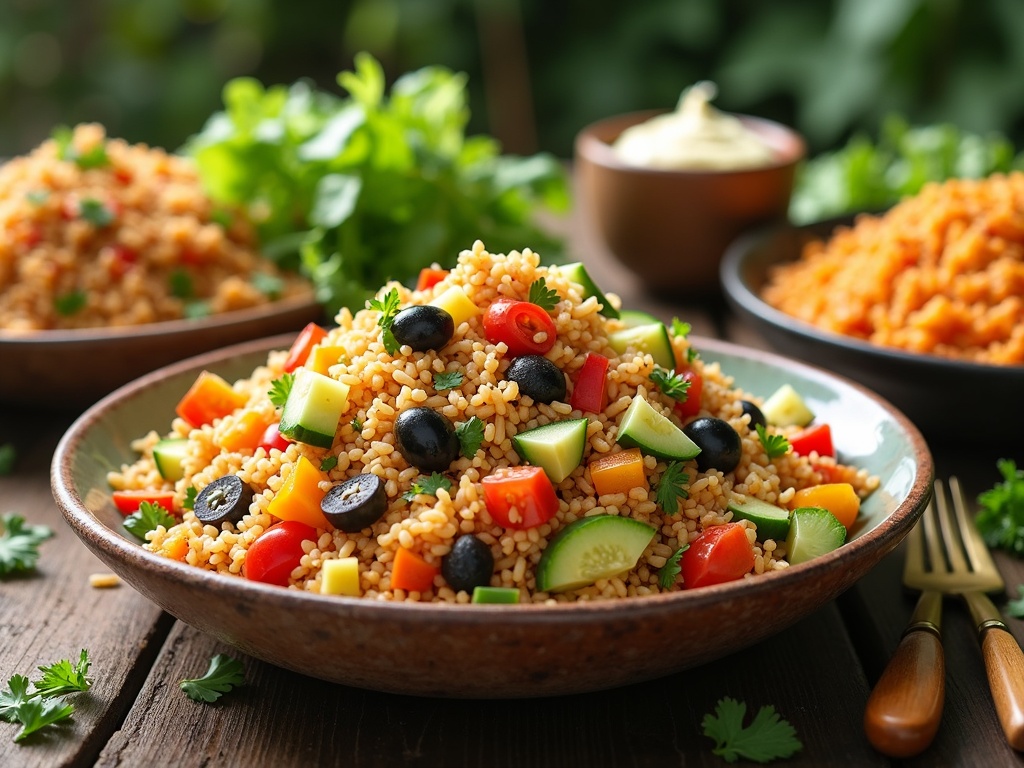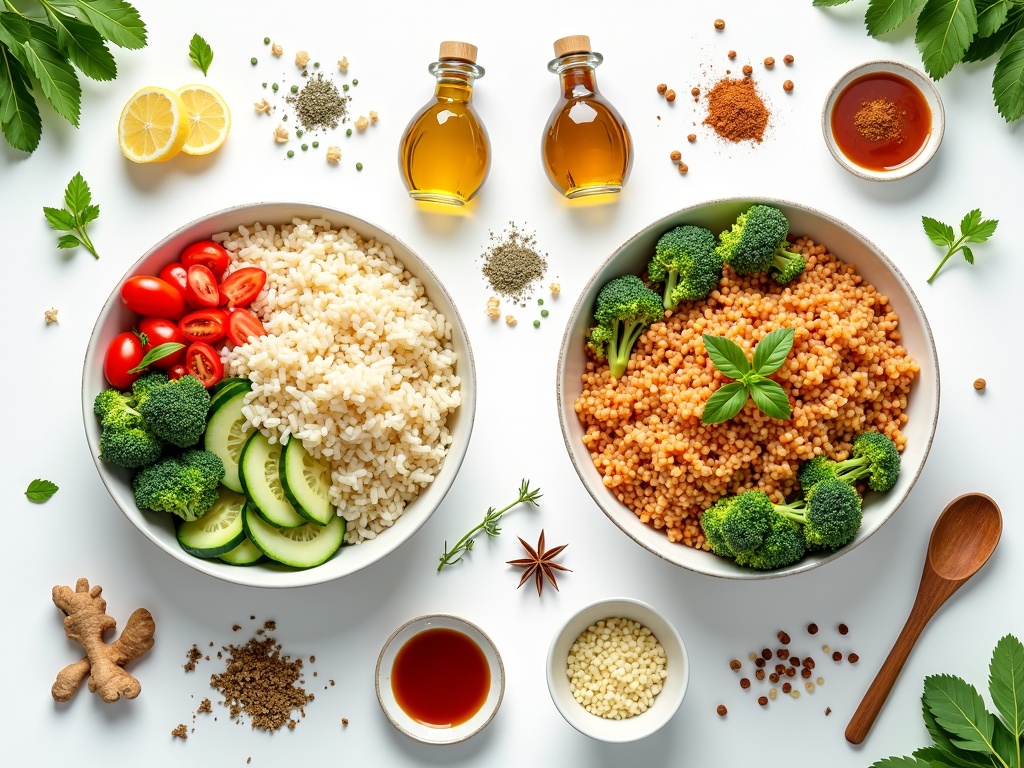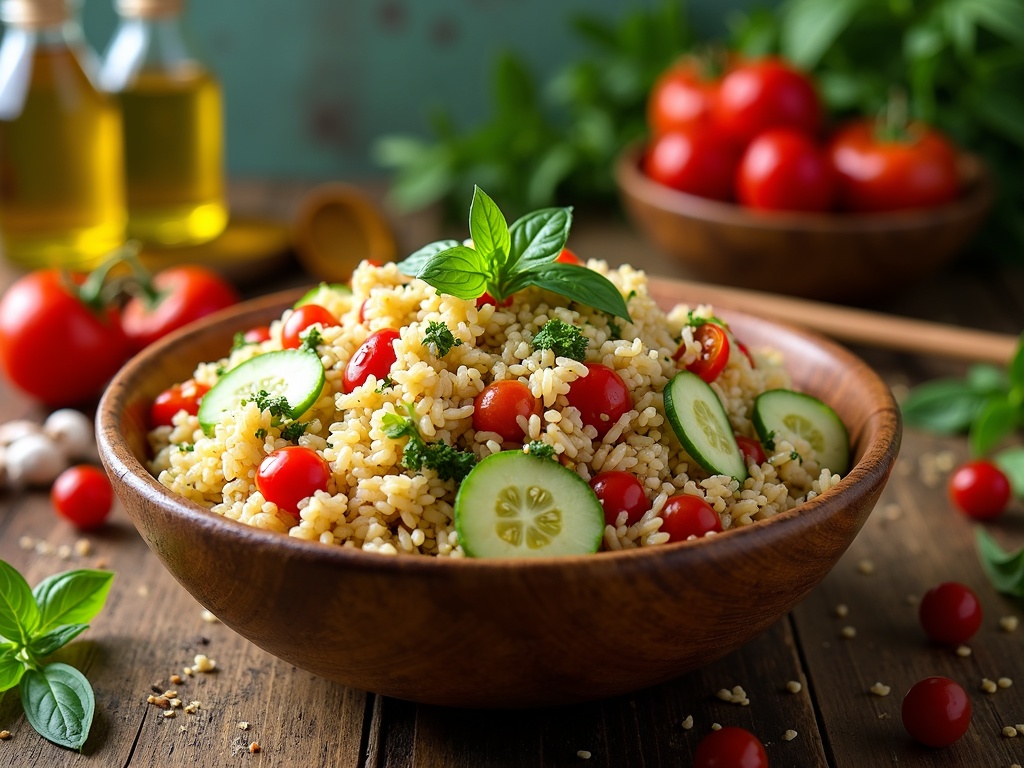Rice salad delivers a versatile and nutritious meal that combines great taste with health benefits. Brown rice adds 3.5g of fiber per cup and 16% of your daily magnesium needs. This flexible dish spans Mediterranean, Asian, and American styles and can be served warm, cold, or at room temperature—perfect for main courses or side dishes.
Find In This Article
Key Takeaways
- A typical serving of rice salad contains just 200-300 calories, making it ideal for those watching their caloric intake without sacrificing fullness.
- The foundation of a great rice salad begins with selecting the right rice variety – basmati for Mediterranean flavors, jasmine for Asian-inspired dishes, or brown rice for added nutrition.
- Rice salads are excellent for meal prep, often tasting better the next day as flavors meld together, and can stay fresh for 3-5 days with proper storage.
- The ideal dressing ratio is typically 3 parts oil to 1 part acid, though this can be adjusted to 2.5:1 for stickier rice varieties.
- Brown rice significantly outperforms white rice nutritionally, offering more B vitamins, fiber, and steady energy release that helps regulate blood sugar levels.
Why Rice Salad is Your Next Healthy Meal Choice
Looking for a nutritious meal that won’t leave you hungry? Rice salad might be exactly what you need. This versatile dish packs a serious nutritional punch while being incredibly adaptable to different tastes and dietary needs.
Nutritional Powerhouse with Global Appeal
A typical serving of rice salad contains just 200-300 calories, making it perfect for those watching their caloric intake without sacrificing satisfaction. The base ingredient alone delivers impressive benefits – especially if you opt for brown rice, which provides about 3.5g of fiber per cup, helping you feel fuller longer.
Brown rice is also rich in essential minerals, providing approximately 16% of your daily recommended magnesium in a single cup. This mineral plays a key role in muscle function, blood pressure regulation, and bone health.
Rice salads aren’t just nutritious – they’re part of culinary traditions worldwide. I’ve found wonderful variations across Mediterranean, Asian, and American cuisines, each adding their unique ingredients and flavor profiles to this simple dish.
The beauty of rice salad lies in its flexibility. You can enjoy it:
- Warm as a hearty main dish
- Cold as a refreshing side
- At room temperature for picnics and packed lunches
- With endless combinations of vegetables, proteins, and dressings
For a Mediterranean twist, try mixing flavorful pilau rice with cucumber, olives, and fresh herbs. If you prefer Asian flavors, Chinese fried rice can be transformed into a delightful salad with the addition of crisp vegetables and a light vinaigrette.
Health-conscious eaters will appreciate pairing jeera rice with roasted vegetables for a warm salad, or adding it to healthy salad recipes for additional substance.
For a complete meal, consider adding a side of rocket salad or other green salad recipes to increase your vegetable intake while enjoying complementary flavors.
Rice salads are particularly appealing for meal prep – they often taste even better the next day as flavors meld together, making them perfect for busy weekday lunches when you need something substantive yet light.

Choosing the Perfect Rice and Mix-ins
The foundation of any great rice salad begins with selecting the right type of rice. I’ve found that different rice varieties can completely transform the texture and flavor profile of your dish.
Rice Varieties and Mix-in Options
Basmati rice offers a fragrant, fluffy texture that pairs beautifully with Mediterranean or Middle Eastern flavors. Its distinct aroma makes it perfect for a pilau rice inspired salad. Jasmine rice brings a subtle sweetness and works wonderfully with Asian-inspired dressings, similar to what you might find in a Chinese fried rice dish. Brown rice provides a nutty flavor and chewy texture, adding extra fiber and nutrients. For something different, try wild rice with its earthy flavor and fantastic crunch.
Fresh vegetables bring color, texture, and nutrition to your rice salad. Consider these options:
- Cucumbers: Add refreshing crunch and hydration
- Bell peppers: Bring vibrant color and vitamin C
- Red onions: Provide a sharp bite (soak in cold water to mellow the flavor)
- Cherry tomatoes: Contribute juicy bursts of acidity
- Olives: Add briny depth of flavor
Protein transforms your rice salad from a side dish to a complete meal. Grilled chicken offers lean protein, while tuna brings omega-3 fatty acids. Chickpeas and tofu make excellent plant-based alternatives that absorb surrounding flavors beautifully.
For added crunch and healthy fats, I love incorporating nuts and seeds. Toasted almonds or walnuts complement the nuttiness of brown rice particularly well. A sprinkle of sunflower or pumpkin seeds can add texture without overpowering other ingredients.
Fresh herbs elevate any rice salad from good to exceptional. Basil pairs beautifully with tomatoes in summer salads, while parsley adds brightness year-round. Consider adding mint for a refreshing twist to your jeera rice inspired salad.
Seasonal vegetables ensure maximum flavor and nutrition. Spring calls for tender asparagus and peas, while summer brings zucchini and corn. Fall offers butternut squash and Brussels sprouts, and winter highlights hearty greens like kale. Pairing these seasonal vegetables with complementary healthy salad recipes components creates balanced, satisfying meals.
For a peppery kick, consider adding rocket salad (arugula) which contrasts beautifully with the milder rice flavors. Or incorporate elements from traditional green salad recipes like crisp lettuce varieties for added freshness.
The beauty of rice salads lies in their flexibility – I can adjust ingredients based on what’s available or what flavors I’m craving that day.
Make Your Perfect Dressing
The secret to a memorable rice salad lies in its dressing. I’ve discovered that the right combination of oils, acids, and seasonings can transform a simple pilau rice dish into something extraordinary.
Mediterranean and Asian Flavor Profiles
For a Mediterranean-style dressing, I start with a base of good quality olive oil and fresh lemon juice. The ideal ratio is 3 parts oil to 1 part acid, which creates a smooth emulsion without overwhelming the rice. Adding minced garlic, dried oregano, and a touch of honey balances the flavors perfectly.
If you prefer Asian flavors for your Chinese fried rice salad, combine toasted sesame oil with soy sauce in a 2:1 ratio. I enhance this mixture with rice vinegar, grated ginger, and a small amount of honey or maple syrup to round out the umami notes.
Spices can elevate your dressing from good to magnificent. When making a rice salad with jeera rice, I add ground cumin, smoked paprika, and a pinch of coriander to create depth. These warm spices complement the nutty flavor of rice beautifully.
To maintain the perfect texture in your healthy salad recipes, keep the dressing separate until just before serving. This prevents the rice from becoming soggy and allows each grain to maintain its integrity. For packed lunches, I store the dressing in a small container and add it just before eating.
For crisp vegetables in your rice salad, try these approaches:
- Salt and drain water-heavy vegetables like cucumbers or tomatoes before adding them
- Blanch harder vegetables like broccoli or green beans, then shock in ice water
- Add crunchy elements like toasted nuts or seeds at the last minute
- Incorporate fresh herbs like those found in rocket salad just before serving
The perfect dressing ratio depends on your rice variety. For stickier rice varieties, I use a slightly more acidic dressing (2.5:1 oil to acid) which cuts through the starchiness. For fluffy, separate grains, a 3:1 ratio works better, allowing the rice to shine while still imparting flavor.
Remember that rice acts as a flavor sponge, so I always make my dressings slightly more intense than for regular green salad recipes. This ensures the final dish has the right balance of flavor in every bite.

Boost Your Nutrition with Every Bite
Rice salad isn’t just a delicious meal option—it’s a nutritional powerhouse that can transform your diet without sacrificing flavor. I’ve discovered that combining nutrient-dense vegetables with the right type of rice creates a perfect balance of taste and health benefits.
Nutritional Powerhouses in Every Bowl
The vegetables you choose for your rice salad can dramatically impact its nutritional profile. Bell peppers and cucumbers are excellent low-calorie additions, containing just 30-50 calories per cup while providing exceptional nutritional value. These colorful vegetables aren’t merely garnishes—they’re packed with Vitamins A and C, which support immune function and skin health.
When making a healthy salad recipe, the type of rice you select forms the foundation of your dish’s nutritional value. Brown rice offers significantly more benefits than white rice, making it my go-to choice for nutritious rice salads. The difference lies in the processing—brown rice retains its bran and germ layers, which house most of the grain’s nutrients.
The B vitamin content comparison between rice types reveals why brown rice deserves its superfood status. Brown rice contains substantial amounts of B vitamins, including B1 (thiamine), B3 (niacin), and B6, which are crucial for energy metabolism and nervous system function. White rice, having lost these nutrient-rich outer layers during processing, contains fewer of these essential vitamins.
Fiber content is another compelling reason to choose brown rice for your green salad recipes. A single cup of brown rice provides about 3.5 grams of fiber, compared to less than 1 gram in white rice. This extra fiber does more than just aid digestion—it helps with weight management by promoting fullness and reducing overall calorie intake.
The impact on metabolic health extends beyond simple calorie counting. The fiber and nutrients in brown rice help regulate blood sugar levels, preventing the spikes and crashes that can trigger hunger and energy slumps. This steady energy release makes pilau rice salads ideal for midday meals when you need sustained energy.
I often combine brown rice with ingredients like chickpeas, fresh herbs, and a light vinaigrette to create a meal that’s as satisfying as it is nutritious. Adding protein sources like grilled chicken or tofu transforms a simple side into a complete meal that keeps you full for hours.
For a flavor twist, consider using jeera rice as your base. The cumin seeds add digestive benefits while imparting a warm, aromatic quality to your salad. Alternatively, Chinese fried rice can be cooled and mixed with fresh vegetables for a fusion-inspired dish.
Don’t forget to include leafy greens like rocket salad to boost the antioxidant content of your dish. The peppery flavor of rocket pairs beautifully with the nutty taste of brown rice and adds visual appeal with minimal calories.
By thoughtfully combining these elements, you’ll create rice salads that deliver maximum nutrition with every bite. The beauty of this approach is its flexibility—you can adjust ingredients based on seasonal availability while maintaining the core nutritional benefits that make rice salads such a smart dietary choice.
Smart Storage and Meal Prep Solutions
Rice salad is one of those versatile dishes I love having on hand for quick meals throughout the week. With proper storage techniques, you can keep your rice salad fresh and delicious for 3-5 days, making it perfect for meal prep.
Maintaining Freshness and Texture
The key to storing pilau rice salads or any rice-based salad is using the right container. I’ve found glass containers with airtight seals work best as they don’t absorb odors or stains like plastic sometimes can. If you’re layering ingredients for a make-ahead healthy salad, always place heavier, more moisture-resistant ingredients at the bottom.
For proper layering in your containers:
- Start with sturdy ingredients like Chinese fried rice or jeera rice as your base
- Add protein components in the middle layer
- Keep delicate items like rocket salad leaves or herbs separate until serving
- Store dressings in separate containers to prevent sogginess
Temperature matters significantly when storing rice salads. Cool your rice completely before combining it with other ingredients—warm rice creates condensation, which leads to sogginess. Once prepared, refrigerate your salad promptly at 40°F (4°C) or below to prevent bacterial growth.
To maintain the best texture quality in your green salad with rice, I avoid freezing rice salads as thawing can make them mushy. Instead, I slightly undercook the rice if I know I’ll be storing it for several days—it’ll hold its structure better.
When it’s time to enjoy your prepped rice salad, let it sit at room temperature for about 15-20 minutes before serving—cold temperatures dull flavors. If you prefer it warm, a quick 30-second microwave stint works for small portions, but be careful not to overheat, which can make the rice dry out. Stirring in a splash of olive oil or a bit of fresh dressing can revive any rice salad that seems dry after storage.
By following these storage guidelines, your rice salads will remain fresh and flavorful throughout the week, saving you time while ensuring delicious, ready-to-eat meals.
Sources:
Health magazine – “Healthy Meals: Rice Salad Variations”
Food Science Journal – “The Nutritional Benefits of Rice”
Cooking Guide – “Meal Prep Made Easy: Tips for Rice Salads”
Nutrition Today – “Rice Varieties and Their Health Benefits”

